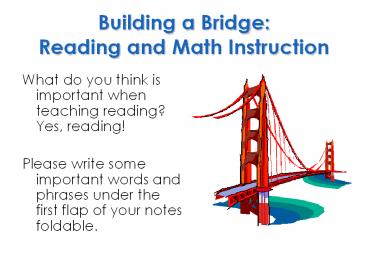Building a Bridge: Reading and Math Instruction - PowerPoint PPT Presentation
1 / 18
Title:
Building a Bridge: Reading and Math Instruction
Description:
Reading and Math Instruction What do you think is important when teaching reading? Yes, reading! Please write some important words and phrases under the first flap of ... – PowerPoint PPT presentation
Number of Views:40
Avg rating:3.0/5.0
Title: Building a Bridge: Reading and Math Instruction
1
Building a BridgeReading and Math Instruction
- What do you think is important when teaching
reading? Yes, reading! - Please write some important words and phrases
under the first flap of your notes foldable.
2
Building a BridgeReading and Math Instruction
- Do a Think-Share-Write-Share
- Read the article given
- Highlight anything that stands out
- Share your ideas with a partner
- In the 2nd flap of your foldable, write
words/phrases that good reading and math
instruction should have in common. - Be ready to share
3
Guided Math
- Rebecca Radicchi
- Better Together Workshop
- Picketts Mill Elementary
- November 4, 2008
Based on the resources provided by the Cobb
County District K-5 Math Coaches
4
What is Guided Math?
- One component of a balanced mathematics program
- Students learn in small flexible groups based on
instructional level - Students work in appropriate standards-based
workstations
5
Guided Math vs. Compacting vs. Whole Group
Whole Group Compacting Guided Math
One standard Not differentiated One lesson After lesson, teacher must help 5-8 struggling kids Advanced kids speed through work and read when finished Not all kids have same understanding of different concepts Minimal discussion of thinking Not fully balanced instruction Possibly different standards Differentiated Based on percentage on IMI One lesson Even leveled kids have different needs based on different standards Kid stays with group through nine weeks or unit Minimal discussion of thinking Not fully balanced instruction One standard Differentiated Small group Based on need on individual standards (IMI and daily formative assessment) One tiered lesson Groups are flexible, change frequently No student is ever finished Balanced instruction
6
Daily Math Rap 15-20 Minutes Review and Practice of the GA Performance Standards
Hook/Activator 10-15 Minutes Whole group standards-based lesson
Work Time 35-45 Minutes Small group reteach, conferencing /or extension Collaborative problem-solving Workstations Manipulative discovery and connections
Summary 5-10 Minutes Review important concepts Reflect
Total Time 75 Minutes
7
What does Guided Math look like?
- Includes
- Workstations based on the standards
- Students working independently, in groups, and/or
with teacher - Teachers formally and informally assessing
student progress - A part of math instruction 2 or more days a week
8
How do I set up my groups?
- Originally based on the Pre-IMI Analysis by
standard - Group according to analysis of standards not
necessarily total missed - Can have 2-3 groups
- Groups can/should change regularly based on
student understanding
9
Guided Math Workstations
- Set up around the room on desks, tables, or
bulletin boards (remember technology) - Put in tubs and placed on students desks
- Based on concepts to maintain and/or concepts
to learn - Should access levels of Blooms
10
Guided Math Students . . .
- Keep work in progress in a folder
- Keep a record of which workstation they complete
daily along with any products in a workstation
folder - Are accountable for keeping up with workstation
work, recording completed workstation daily, and
producing quality work
11
Guided Math Teachers . . .
- Set up standards-based workstations based on
student need - Lead whole group discussion about the
workstations at least once a week - Develop a system for recording what the
students are doing in the workstations
12
How do I get started with workstations?
- Decide on workstations
- Strands
- GPS concepts to maintain
- Skills being taught
- Multiple intelligence
- Fluency building activity
- Be sure the workstations are authentic,
standards-based activities and not busy work. - Create a planning system and a student log
13
Ideas for Workstations
- Technology Smartboard, computer
- Standards-Based Games card games, etc.
- Problem Solving Exemplars, Logic,
Problem-Solving Deck - Math Journals
- Fluency Building Activities timed tests, flash
cards, etc. - Guided Manipulative Exploration geoboards,
measurement, etc.
Brainstorm some ideas under the Workstation
flap on your foldable. Be ready to share!
14
Summarizing the Lesson
- Math Journal Quick Writes
- Discussion
- Understanding Check
- -thumps up, thumps down, etc.
- -Final Countdown, 3-2-1, Ticket out the
- Door, etc.
- Review and answer essential question
- Math Chair or Hot Seat
- -Could use sample math journal prompts for
students to respond to - -Read math journal
- Reread standard, ask kids if they met the
standard.
15
What Now?
- Decide on rules and routines
- Set up groups
- Create a schedule
- Develop accountability form
- Plan group and mini-lessons
- Design workstations
16
Math Workstation Resources
- Laura Candler
- MathWire
- Georgia Standards.org Math Frameworks
- Public Schools of NC Problem-Solving Decks
- My Blog
- Cobb Math Blog
- Cobb Math Links List
- Plug Into Mathematics
- WESTEST Prep Page
- Teams Educational ResourcesGrades 3-5/Function
MachineAgebra, Geometry and Numbers
- Mrs. Powells Math Tubs Explanation
- Marcias Math Tub Fun
- Mrs. Meachams Math Tubs
Resources You Already Have 1. Standards-based CDs
and board games2. Think Math (came with
new math resources last year)3.
Investigations 4. Everyday Counts/Partner Games
5. Exemplars6. SmartBoard and hands on
manipulatives
17
Is it Your Lucky Day?!
If you have the word Time written on the back
of your agenda, you win The Gift of Time!
If you have the words Door Prize written on the
back of your agenda, you can choose a door prize!
18
Special Thanks To
- Ashley Kirby, Area 6 Lead Teacher, for sharing
resources - Cobb County Math Coaches for presentation
materials































